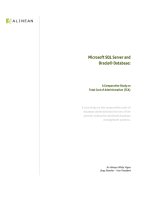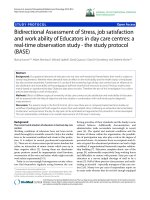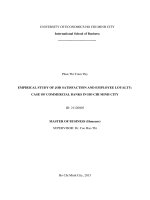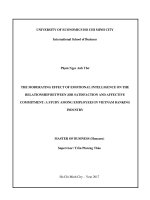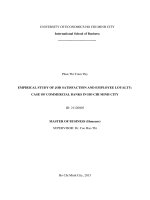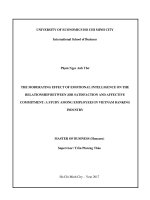EMOTIONAL INTELLIGENCE, WORK STRESS, JOB SATISFACTION, AND EMPLOYEE CREATIVITY: A CRITICAL STUDY ON VIETNAMESE UNIVERSITIES - Full 10 điểm
Bạn đang xem bản rút gọn của tài liệu. Xem và tải ngay bản đầy đủ của tài liệu tại đây (524.31 KB, 17 trang )
Indian Journal of Economics and Business
Vol. 20 No. 3 (December, 2021)
Copyright@ Ashwin Anokha Publications & Distributions
/>
Emotional Intelligence, Work Stress, Job Satisfaction, and
Employee Creativity: A Critical Study on Vietnamese
Universities
Huynh Thi Thu Suong, To Anh Tho
University of Finance – Marketing, Ho Chi Minh City, Vietnam.
Corresponding author: ,
Received:07th July 2021
Revised:21st August 2021
Accepted: 03rd September 2021
Abstract: Although a lot of research on job creativity has already been conducted from a psychological
viewpoint, there is a limited number of studies considering work stress and emotional intelligence as higherorder constructs when investigating their impacts on employee creativity. This research aims to examine
how emotional intelligence and work stress affect job satisfaction, and whether satisfaction and emotional
intelligence enhance employee creativity. By analyzing PLS-SEM with higher-order constructs for a sample
of 207 lecturers at Vietnamese universities of economics, the results revealed a negative impact of work
stress and a positive impact of emotional intelligence on job satisfaction. Besides, the positive influences of
job satisfaction and emotional intelligence on employee creativity are also supported. This investigation
highlights the importance of developing emotional intelligence and controlling work stress to enhance job
satisfaction and creativity in the context of Vietnamese universities.
1. Introduction
Management scholars have found that job satisfaction can be determined by emotional intelligence
(Miao et al., 2016; Yan et al., 2018; Sy et al., 2006). Emotional intelligence can be defined as “an
awareness and understanding of people's feelings, including one's own, and how to use this knowledge to
engage effectively in interpersonal relationships in a wide variety of contexts and situations. People with high
levels of emotional intelligence have more success, enjoy a broader network of colleagues, are more respected,
and can negotiate solutions to problems with greater ease” (Collins, 2018). Some studies also emphasize
the need to explore the relationship between emotional intelligence and creativity (O’Boyle et al.,
1149
EMOTIONAL INTELLIGENCE, WORK STRESS, JOB SATISFACTION, AND EMPLOYEE CREATIVITY
2011; Joseph & Newman, 2010). In addition, work stress is also recognized as a critical antecedent
of job satisfaction, whereas work stress can be structured from challenge and hindrance stressors.
Different from previous studies, this paper provides a new research framework with two high-order
constructs of emotional intelligence and work stress. We consider work stress to be a higherorderconstruct that includes both challenge and hindrance stressors. Similarly, emotional
intelligence is conceptualized as a higher-order construct consisting of self-emotional appraisal
(SEA), others’ emotional appraisal (OEA), use of emotion (UOE), and regulation of emotion
(ROE). In the context of PLS-SEM, higher-order models cut down structural paths rather than
developing ties among many independent and dependent structures (Becker et al., 2012; Polites et
al., 2012; Johnson et al., 2012). In addition, higher-order models offer the means to minimize
homogeneity between formative indicators (Hair et al., 2018).
Moreover, most of the previous studies on emotional intelligence, employee creativity, job
pressure, and job satisfaction were mainly conducted at companies, but the number of studies for
educational institutions/universities is still limited, especially in developing countries. This
motivates us to investigate the above relationships at Vietnamese universities. Nowadays, many
Vietnamese universities are competing, so creativity and innovation are highly valued and often
vital to universities’ survival. Lecturers usually face the issues concerned with the demands and
expectations of parents, the requirements of educational managers, the non-serious attitude of
students, technology and educational reforms, heavy workload, and so forth. Such issues lead to
emotional disturbance, work stress, job dissatisfaction.
This article is organized as follows. We first review the constructs of emotional intelligence,
employee creativity, job satisfaction, and work stress in the second section. Then, the hypotheses
are developed to set up a proposed model. In section 4, we mention the methodology. In the
conclusion, the article gives a brief discussion of the contribution to management, the limitation,
and future research.
2. Literature review
Emotional Intelligence (EI)
During the last few decades, emotional intelligence (EI) has attracted the attention of experts
because it is of the utmost importance in several realms of life (Soleimani & Einollah Zadeh,
2017). EI is defined by Goldeman (2001) as “the capability of noticing the inner feelings of oneself and
others, encouraging oneself, regulating feelings, and managing human relationships”. Previously, Mayer and
Salovey (1997) define EI as a set of interrelated skills concerning “the ability to perceive accurately,
appraise, and express emotion; the ability to access and/or generate feelings when they facilitate thought; the
ability to understand emotion and emotional knowledge; and the ability to regulate emotions to promote
emotional and intellectual growth”. In other words, employees with high EI tend to look assertive,
1150
Huynh Thi Thu Suong, To Anh Tho
optimistic, tolerant, and flexible because they can handle well and always think positively (Griffeth,
et al., 2000). At the same time, Higgs (2000) stated that EI referred to feeling and how you can
manage these emotions, motivation for doing things, imagination and success, sensitivity, and
successful handling of relationships.
EI has an impact on a wide variety of work activities, including teamwork, talent growth, creativity,
quality of service, and client loyalty. (Delcourt et. al., 2013). EI could affect employees’
interpersonal relationships with their supervisors, co-workers, and their workload. Similarly, it
could foresee important results relating to jobs, including job satisfaction. (Abraham,2000),
creativity, innovation in work (Gardner, 2003). EI was defined by Hogeveen et al. (2016) as the
ability to accurately and effectively handle emotional knowledge. Based on these definitions, EI
can be operated in four aspects: self-emotional appraisal, others’ emotional appraisal, regulation of
emotion, and use of emotion (Khalid et al., 2018; Choi et al., 2019).
Self - Emotional Appraisal (SEA)signifies an assessment and an expression of an emotion that
relates to the capacity of a person to understand and identify his/her deep emotions. The principle
of SAE is utilizing the capability to remain stable and calm throughout provocation or
confrontation, meanwhile maintaining minimal defense and eventually developing rationality
(Wolmaran & Martins, 2001; Brackett, et al. 2010). In a sequence of levels, self-regulation
advances chiefly from social sources and adjustments of individual sources. SEA would allow
individuals to play a greater role in their ideas, feelings, and performances (Schunk &
Zimmerman, 2012).
Others’ Emotion Appraisal (OEA) means the assessment and recognition of other people’s
emotions. According to Grayson (2013), it reflects “the capability to notice one’s emotions, to distinguish
them, to fully understand what and why one feels, and to acknowledge the reasons for any feeling”. People
who are good at this capacity would easily read others’ minds as well as be receptive to the
thoughts and feelings of others. Emotional self-awareness is a method of recognizing the emotions
of a person and observing how they might influence humans.
Use of emotion (UOE)describes the ability to regulate emotional impulses as an emotional
motivation that enables others to achieve their objectives (Anari, 2012). Self-motivation also
includes the opportunity to set objectives and to establish a hard and optimistic reverse effect. Selfmotivation is the guarantee which will be engaged in daily activities for a specific purpose
(Mohamad & Jais, 2015).
Regulation of emotion (ROE)expresses one’s ability to control his/her feelings, which would lead
to quicker healing from psychological distress. It is related to social skills which help a person to
maintain relationships with others. Respect, shared concern, engagement, generosity, patience,
tolerance, compassion, compromising, debate, and communication are important social skills
1151
EMOTIONAL INTELLIGENCE, WORK STRESS, JOB SATISFACTION, AND EMPLOYEE CREATIVITY
(Schuetz, 2011). It also involves satisfying the needs of each other, communicating, and consulting
about one’s feelings, ideas, and thoughts. There are also other social skills as well as qualities that
are proved to be effective in creating innovation, convincing others, building, guiding, and leading
teams.
Job satisfaction (JS)
Job satisfaction means the feeling of satisfaction with one’s work, which is seemingly considered to
be a strong reason or motivation for working. This term relates to the link between an employee
and the company for which he/she works (Gayathiri & Ramakrishnan, 2013). It also illustrates the
attitudes of workers, thus bringing about a bright atmosphere to the workplace (Aziri, 2011; Luz &
Oliveira (2018). Lizote et al. (2017) also indicate JS as an emotional state, depending on whether
or not a set of standards has been met. Employees’ satisfaction is a positive feeling which
encourages them to increasingly try their best to sacrifice for their company. As a consequence, JS
improves overall efficiency and helps the organization meet its goals (Khan, 2016). For Paula &
Queiroga (2015), “satisfaction is one of the fundamental variables for any organization concerned with
maintaining good practices of human resources management”.
The positive impact of emotional intelligence on job satisfaction was proved in many previous
studies (Anari, 2012; Yin et al., 2013; El Badawy & Magdy, 2015; Judge & Kammeyer-Muller,
2012; Joshi et al., 2015). Employees who cannot regulate their emotions properly, show less job
satisfaction. Even, Mayer et al. (2004) supported that individuals with high EI tend to have high
organizational commitment. Also, Lopzs et al. (2004) supposed EI to be necessary to promote
social contact and work interaction. People with high EI tend to build up job satisfaction day by
day through experiences based on constructive social exchange. Therefore, our first hypothesis is
constructed as follows:
H1: Emotional Intelligence positively influence job satisfaction
Work stress (WS)
This concept is considered as the psychology of a person with thoughts and emotional experiences
related to their working place and environment (Chang-Yang et al., 2015). Specifically, when there
is a situation where the requirements exceed the personal and social resources, the employee could
suffer a status of extreme hardship, distress, or insult which is referred to as the biggest and most
worrying risk and stress. Stress is a perceived emotion. It is a continuum of emotional, spiritual,
behavioral, and physical reactions ignited by new or developing pressures (Lu & Kuo, 2016). Work
stress is often the product of employee-facing expectations, pressure, and negative responses that
are inconsistent with their range of expertise, thereby creating obstacles and risks to employee
career (Bashir & Ramay, 2010). According to Ding et al. (2019), WS can be conceived into two
1152
Huynh Thi Thu Suong, To Anh Tho
types: challenge and hindrance stressors.
Challenge Stressors (CS) can cause stress, but they also provide workers with motivations and
opportunities to succeed and develop (Cavanaugh et al., 2000). Work range, responsibility,
workload, and time pressure are its factors. There is rising proof that stressors may have beneficial
ties to the motivation, happiness, and success of employees (Podsakoff et al., 2007; LePine et al.,
2005).
Hindrance stressors (HS) cause stress but do not support workers with growth and development
opportunities, as opposed to challenge stressors (Cavanaugh et al., 2000). These include business
strategy, bureaucracy, the uncertainty of employment, and work instability (Lu & Kuo, 2016). HS
is believed to limit personal output and thus inhibit the advancement of an employee's objective.
Due to the composition of job demands, which are assumed to be unstable at almost all levels,
these stressors are likely to generate negative affective and behavioral responses from workers that
correlate to their perceived stress levels (Tsaur &Tang, 2012).
Work stress is a major factor leading to job dissatisfaction (Lambert et al., 2018; Joshi et al., 2015).
The more stressed an employee is, the lower the level of satisfaction with his job is. This statement
is reinforced by Rehman (2012) and Chang-Yang (2015), who indicated that the link between
stress and satisfaction at work is extremely contradictory. The studies conducted for medical and
police services by Trivellas (2013) and Gyamfi (2014) have shown similar results.WS was also
regarded as a cause of negative results such as the discontent of workers, psychological distress,
burnout, turnover intention(Jung & Yoon, 2014;Yeung, 2009). The authors, therefore, theorize
the hypothesis below:
H2: Work stress is negatively related to job satisfaction
Employees creativity (EC)
EC means the development of innovative and useful ideas relating to goods, services, procedures,
or processes in companies (Scott, & Bruce, 1994; Farmer et al., 2003). Zhou & Hoever (2014) also
agreed that creativity is the process by which new ideas are executed. Creativity is established
deeply and firmly from one’s own experience and knowledge, which requires a high intellectual
level. Therefore, the creative mind of employees is recognized as one of the primary components
that make up the success and development of businesses (Sacramento et al. 2013).
The literature has found connections between emotional aspects and creative performance,
indicating that emotions are conducive to creativity (Lassk, &Shepherd, 2013; Geher et al., 2017;
Zampetakis et al., 2009). Sternberg (1985) also indicated that emotional intelligence needs to be
efficiently controlled to function creatively every day. Those having high EI can also get high
1153
EMOTIONAL INTELLIGENCE, WORK STRESS, JOB SATISFACTION, AND EMPLOYEE CREATIVITY
creativity scores. Once employees perform creatively, their daily tasks will be innovated efficiently
(Ding & Liu, 2019). Therefore, the hypothesis is formulated as follows:
H3: Emotional intelligence is positively related to employee creativity
When individuals feel treated well, they tend to be more involved in all activities with their best
efforts for their organization (Zhou & Hoever, 2014). The five most important issues concerning
job satisfaction are working conditions, reward policy, relationship, work environment, and nature
of work (Sacramento et al., 2013). When people perform jobs with satisfaction, they often think
about how their work can be improved or come up with the best ideas to devote to their
organization (Whitelock et al., 2008). As a result, they will willingly utilize their resources to
contribute to the development of the organization without any hesitation or considering receiving
any benefits in return. Soleimani & Einolahzadeh (2017) also confirmed a positive link between
job satisfaction and employee creativity. Hence, the fourth hypothesis is given as follows:
H4: Job satisfaction is positively related to employee creativity
Emotional intelligence
H3
H1
Work stress
H2
Employee creativity
H4
Job satisfaction
Figure 1. The proposed research framework
3. Method
Data collection
A questionnaire was developed and sent to the full-time lecturers working at ten well-known
universities of economics in Ho Chi Minh City, Vietnam. We contacted them through emails,
telephone, and personal visits from June to August 2020. About 700 questionnaires were
distributed. We only received 228 responses, for a response rate of 32.57 percent. By discarding 21
incomplete or inconsistent responses, 207 questionnaires can be used for further analysis.
Table 1. Respondents’ profile
Measure
Gender
Frequency
92
115
Value
Female
Male
1154
Percent
44.4%
55.6%
Huynh Thi Thu Suong, To Anh Tho
Age
Education
Experience
22 to below 30 years
30 to below 35 years
35 to below 40 years
40 to below 45 years
45 to below 50 years
50 years and above
Master
Doctor
Below 5 years
5 to below 10 years
10 to below 15 years
15 to below 20 years
20 years and above
4
46
42
52
33
30
149
58
15
65
52
40
35
1.9%
22.2%
20.3%
25.1%
15.9%
14.5%
72.0%
28.0%
7.2%
31.4%
25.1%
19.3%
16.9%
Source: Authors’ calculations
Table 1 provides the respondents’ demographic information. Out of 207 lecturers, around half of
them were male (55.6%), more than 67% were from 30 to 45 years old. Notably, only 28% had
their doctoral degree but it appropriately reflects the status of lecturers' qualifications at
Vietnamese universities. In 2019, Vietnam has 73,312 lecturers while nearly 21,000 lecturers hold
doctoral degrees, accounting for more than 28% (Ngoc Linh, 2021).In addition, more than 60%
had over 10 years of teaching experience.
Questionnaire development
Following Wong and Law (2002), Khalid et al. (2018), and Choi et al. (2019), this study measures
emotional intelligence through the self-reported WLEIS scale, consisting of four factors such as
self-emotional appraisal (SEA), others’ emotional appraisal (OEA), use of emotion (UOE), and
regulation of emotion (ROE). According to Ding et al. (2019), work stressors were also
conceptualized as a higher-order construct, including challenge stressors (CS) and hindrance
stressors (CS). Job satisfaction was adapted from Michigan Organizational Assessment
Questionnaire Job Satisfaction Subscale (Cammann et al., 1979). Employee creativity was
shortened from Scott & Bruce (1994) and Zhou & George (2001). Moreover, all measures were
anchored with the 5-point Likert scale(1 = “Strongly disagree;” 5 = “Strongly agree”). A
professional translator translated the questionnaire from English into Vietnamese.
Data analysis
According to Andersen & Gerbing (1988), we used the two-step analysis approach with Smart PLS
version 3.0 to analyze the research model. First, we tested the validity and reliability of the
measures. Second, we evaluate the postulated connections of the structural model described above,
1155
EMOTIONAL INTELLIGENCE, WORK STRESS, JOB SATISFACTION, AND EMPLOYEE CREATIVITY
a bootstrapping method (1000 resamples) was used to determine the significance levels of path
coefficients.
4.Findings and Discussions
Measurement model assessment
Table 2. Loadings, AVE, CR, and Cronbach’s Alpha for the first-order constructs
First-order constructs
Self-emotion appraisal (SEA)
Others’ emotion appraisal (OEA)
Use of emotion (UOE)
Regulation of emotion (ROE)
Challenge Stressors (CS)
Hindrance stressor (HS)
Job satisfaction (JS)
Employee creativity (EC)
Measurement
SEA 1
SEA 2
SEA 3
SEA 4
OEA 1
OEA 2
OEA 3
OEA 4
UOE 1
UOE 2
UOE 3
UOE 4
ROE 1
ROE 2
ROE 3
ROE 4
CS 1
CS 2
CS 3
CS 4
HS 1
HS 2
HS 3
HS 4
JS 1
JS 2*
JS 3
EC 1
EC 2
EC 3
Outer
loadings
0.816
0.858
0.816
0.729
0.801
0.859
0.714
0.859
0.786
0.776
0.806
0.818
0.874
0.907
0.869
0.904
0.875
0.868
0.912
0.924
0.805
0.764
0.797
0.778
0.889
0.764
0.868
0.788
0.822
0.837
Source: Authors’ calculations
1156
AVE
CR
0.650
0.881
Cronbach’s
Alpha
0.819
0.657
0.884
0.826
0.635
0.874
0.808
0.790
0.938
0.911
0.801
0.942
0.917
0.618
0.866
0.794
0.709
0.879
0.795
0.666
0.856
0.750
Huynh Thi Thu Suong, To Anh Tho
The accuracy and rationality of the first orders are tested first. As shown in Table 2, the
Cronbach’s Alpha values, outer loadings, and composite reliability (CR) are greater than 0.7,
which firmly demonstrates the reliability of the construction measurements. Besides, Table 2 also
describes the average variance extracted (AVE) to evaluate the convergent validity. All the AVE
values are over 0.5, so convergent validity was established (Hair et al. (2017).
Table 3. VIF and outer weights for second-order constructs
Second-order constructs First-order constructs
Emotional intelligence
Work stressor
Self-emotion appraisal (SEA)
Others’ emotion appraisal (OEA)
Use of emotion (UOE)
Regulation of emotion (ROE)
Challenge Stressor (CS)
Hindrance stressor (HS)
Outer
weights
0.315
0.288
0.309
0.384
0.627
0.486
t-value
VIF
17.346
12.745
13.763
18.621
30.055
31.503
1.594
1.448
1.485
1.547
1.589
1.589
Source: Authors’ calculations
Table 4. HTMT ratio analysis
EC
HS
JS
OEA
ROE
SEA
UOE
CS
0.081
0.709
0.163
0.076
0.132
0.119
0.116
EC
HS
JS
OEA
ROE
SEA
0.073
0.491
0.478
0.533
0.455
0.648
0.336
0.089
0.137
0.207
0.155
0.289
0.407
0.511
0.562
0.481
0.595
0.430
0.535
0.579
0.569
UOE
Source: Authors’ calculations
As for EI and WS, they are conceptualized as higher-order constructs that include many formatted
first-order constructs. In the measurement analysis, there are two types of models: reflective
measurement model and formative measurement model. Following Diamantopoulos et al. (2008),
the CR, AVE, and loadings mostly aid in assessing convergence validation for reflective constructs,
instead of higher-order formative ones. Therefore, the study follows the guideline established by
Hair et al. (2017) to assess the collinearity, weights, and significance of higher-order constructs
(Table3). Variance inflation factor (VIF) lower than 2 shows the absence of multicollinearity (Hair
et al., 2017). By a bootstrapping procedure (1000 samples), T-valuesare over 1.96 (p<0.05), which
suggests that the weights of the constructs are important.
Next, discriminant validity is also examined in Table 4. Henseler & Fassott (2010) suggested that
Heterotrait-Monotrait (HTMT) should be used to test discriminating validity at a cut-off value of
0.85(Henseler & Fassott, 2010; Voorhees et al., 2016).
1157
EMOTIONAL INTELLIGENCE, WORK STRESS, JOB SATISFACTION, AND EMPLOYEE CREATIVITY
Structural model assessment
The path coefficientsand p-values were calculated using a bootstrapping method (Hair et al., 2017).
In addition, a blindfold procedure should be applied to evaluate the predicted application of the
internal mode (Hair et al., 2017).The Q2 predictive relevance for emotional intelligence of 0.209
and work satisfaction of 0.172 using the omission distance of 7 shows that there is predictive
relevance in the model.
Table 5 shows that emotional intelligence has significantly positive impacts on both job
satisfaction (β = 0.467, p < 0.01) and employee creativity (β = 0.475, p < 0.01). The findings are in
line with some studies related to the role of emotions and EI in education such as Najmuddin et
al. (2011), Corcoran & Tormey (2012), Asrar-ul-Haq et al. (2017). Emotional intelligence is
extremely beneficial to teachers' performance and job satisfaction since it helps them communicate
clearly, resulting in effective interactions at work and their personal lives (Asrar-ul-Haq et al., 2017;
Mehmood et al., 2013). Individuals with high EI can flexibly adapt their emotions in stressful
situations (Jung & Yoon, 2016).
Table 5. Results of a structural equation modeling
Coefficients
0.467
-0.161
0.475
0.160
H1: Emotional intelligence job satisfaction
H2: Work stress Job satisfaction
H3: Emotional intelligence Employee creativity
H4: Job satisfaction Employee creativity
f square
0.292
0.035
0.257
0.029
P Values
0.000
0.020
0.000
0.031
Source: Authors’ calculations
Next, work stressors have a negative impact on job satisfaction (β = -0.161, p = 0.02). It means that
lecturers who experience more challenge and hindrance stressors feel more job-dissatisfied. They
usually have insufficient time and pressure to meet the requirements of their faculties and
universities. There are many reasons for this problem:
- The simultaneous inappropriate allocation of too many tasks leads to work overload. This
problem stems from not only management ability but also Asian culture. Individuals in a high
power distance society, such as Vietnam, are also required to respect their leaders' authority and
seniority, as well as to accept their leader's commands (Hofstede Insights 2018); which may lead to
a tolerance for workplace mistreatment (Kwan et al., 2014). Besides, the slow application of the
system-based or technology-based management methods to increase the transparency of the
environment is also a big challenge.
- Unlike Western universities, department decisions are so strong in Vietnamese universities, and
lecturers often feel powerless in resolving departmental influences to their careers.
1158
Huynh Thi Thu Suong, To Anh Tho
- Higher stress levels are connected with lower rank, untenured status, and certain discipline
clusters in terms of academic professional features. Failure to provide necessary resources or
supports for high-quality teaching and research, as well as a lack of rewards or inadequate
recognition for their efforts, contribute to their stress and work dissatisfaction.
- In addition, lecturers always try to maintain interactive and friendly relationships with students.
Teaching is a respected profession in Vietnamese culture and tradition, so lecturers must behave
properly in all situations to ensure strict professional ethical standards.
Finally, job satisfaction has a positive impact on employee creativity (β = 0.160, p = 0.031). This
result is consistent with the conclusion of Mahdi et al.(2021) that job satisfaction has a significant
impact on employees' creativity development at Tikrit University, Iraq.
5. Conclusion
The findings show employee creativity is positively affected by emotional intelligence and job
satisfaction. Therefore, to motivate employees to be more creative, a working environment that
fosters better satisfaction and emotion must be provided by the dean or rector. Besides, employees
in Vietnamese universities also place their high hope in administrators that their contributions will
be properly recognized.
Another result is that work stress negatively influences job satisfaction. To reduce pressures at
work, it is necessary to recruit the right people and put them in the right positions. Also,
procedures need to be improved to reduce “bottlenecks” during the operation. Despite that, the
deans or rectors should also pose reasonable challenges for them. If they are happy with their job,
challenges are their motivations rather than obstacles. It will force them to reach their full
potential and boost their creativity.
Even though the results of this study broaden the existing knowledge, several limitations call for
future research. Firstly, only three factors consisting of emotional intelligence, work stress, and job
satisfaction are used to investigate their impacts on creativity. Others should be included in further
research. Secondly, the study failed to explore the moderating influence on the previously
mentioned relationship demographic components. Finally, the framework was examined and
checked only in Ho Chi Minh – a big city in Vietnam. Thus, comparing and contrasting the
results in various places, types, and forms of universities may be interesting.
1159
EMOTIONAL INTELLIGENCE, WORK STRESS, JOB SATISFACTION, AND EMPLOYEE CREATIVITY
Figure 2. Results of the structural model
1160
Huynh Thi Thu Suong, To Anh Tho
REFERENCES
Abraham, R. (2000). The role of job control as a moderator of emotional dissonance and
emotional intelligence–outcome relationships. The Journal of Psychology, 134(2), 169-184.
Amabile, T.M., Barsade, S.G., Mueller, J.S., & Staw, B.M. (2005). Effect and creativity at work.
Administrative Science Quarterly, 50(3), 367-403.
Anari, N. N. (2012). Teachers: emotional intelligence, job satisfaction, and organizational
commitment. Journal of workplace Learning. 24 (4), 256–269.
Asrar-ul-Haq, M., Anwar, S., & Hassan, M. (2017). Impact of emotional intelligence on
teacher ׳s performance in higher education institutions of Pakistan. Future Business Journal, 3(2), 8797.
Aziri, B. (2011). Job satisfaction: a literature review. Management Research & Practice, 3(4),
77-86.
Bashir, U., and Ramay, I. (2010). Impact of stress on Employees Job Performance: A Study on
Banking Sector of Pakistan. International Journal of Marketing Studies, 2(1-2) 2010, 122-126.
Becker, J. M., Klein, K., & Wetzels, M. (2012). Hierarchical latent variable models in PLSSEM: guidelines for using reflective-formative type models. Long range planning, 45(5-6), 359-394.
Brackett, M.A.; Rivers, S.E.; Reyes, M.R.; Salovey, P. (2010). Using emotional literacy to
improve classroom social-emotional processes. In Proceedings of the William T. Grant
Foundation/Spencer Foundation Grantees Meeting, Washington, DC, USA.
Cavanaugh, M.A., Boswell, W.R., Roehling, M.V., & Boudreau, J.W. (2000). An empirical
examination of self-reported work stress among U.S. managers. Journal of Applied Psychology, 85, 6574.
Choi, H. M., Mohammad, A. A., & Kim, W. G. (2019). Understanding hotel frontline
employees’ emotional intelligence, emotional labor, job stress, coping strategies and burnout.
International Journal of Hospitality Management, 82, 199-208.
Collins, J. M. (2018). HR Management in the Forensic Science Laboratory: A 21st Century
Approach to Effective Crime Lab Leadership. Academic Press.
Corcoran, R. P., & Tormey, R. (2012). How emotionally intelligent are pre-service teachers?.
Teaching and Teacher Education, 28(5), 750-759.
Delcourt, C., Gremler, D. D., Van Riel, A. C., & Van Birgelen, M. (2013). Effects of perceived
employee emotional competence on customer satisfaction and loyalty. Journal of Service
Management.
Ding, G., Liu, H., Huang, Q., & Gu, J. (2019). Enterprise social networking usage as a
moderator of the relationship between work stressors and employee creativity: A multilevel study.
Information & Management, 56(8), 103165.
El Badawy, T. A., & Magdy, M. M. (2015). Assessing the impact of emotional intelligence on
job satisfaction: An empirical study on faculty members with respect to gender and age.
International Business Research, 8(3), 67.
1161
EMOTIONAL INTELLIGENCE, WORK STRESS, JOB SATISFACTION, AND EMPLOYEE CREATIVITY
Gardner, H. (2003). Multiple intelligences: the theory in practice. New York: Basic Books Inc.
Geher, G., Betancourt, K., & Jewell, O. (2017). The Link between emotional intelligence and
creativity. Imagination, Cognition and Personality, 37(1), 5-22.
Grayson, R. (2013). Emotional Intelligence: A Summary. Retrieved on 2013 from
Griffeth, R.W., Hom, P.W. and Gaertner, S. (2000). A meta-analysis of antecedents and
correlates of employee turnover: update, moderator tests, and research implications for the next
millennium. Journal of Management, 26(3), 463–488
Gyamfi, G. D. (2014). Influence of job stress on job satisfaction: Empirical evidence from
Ghana police service. International Business Research, 7(9), 108.
Higgs, M. (2000). Do leaders need emotional intelligence?: A study of the relationship
between emotional intelligence and leadership of change. International Journal of Organisational
Behaviour, 5(6), 195-212
Hogeveen, J., Salvi, C., & Grafman, J. (2016). ‘Emotional Intelligence’: lessons from lesions.
Trends in neurosciences, 39(10), 694-705.
Insights, H. (2018). “What about Vietnam?” Hofstede Insights. January 30.
/>Johnson, R.E., Rosen, C.C., Chang, C.-H., Djurdjevic, E., Taing, M.U. (2012).
Recommendations for improving the construct clarity of higher-order multidimensional
constructs. Human Resource Management Review, 22(2), 62-72.
Joseph, D. L., & Newman, D. A. (2010). Emotional intelligence: An integrative meta-analysis
and cascading model. Journal of Applied Psychology, 95(1), 54–78.
Joshi, P., Suman, S. K., & Sharma, M. (2015). The Effect of Emotional Intelligence on Job
Satisfaction of Faculty: A Structural Equation Modeling Approach. IUP Journal of Organizational
Behavior, 14(3).
Judge, T. A., & Kammeyer-Mueller, J. D. (2012). Job attitudes. Annual review of psychology, 63,
341-367.
Jung, H. S., & Yoon, H. H. (2014). Antecedents and consequences of employees’ job stress in
a foodservice industry: Focused on emotional labor and turnover intent. International Journal of
Hospitality Management, 38, 84-88.
Jung, H. S., & Yoon, H. H. (2016). Why is employees’ emotional intelligence important? The
effects of EI on stress-coping styles and job satisfaction in the hospitality industry. International
Journal of Contemporary Hospitality Management, 28, 1649–1675.
Khalid, J., Khaleel, M., Ali, A. J., & Islam, M. S. (2018). Multiple dimensions of emotional
intelligence and their impacts on organizational commitment and job performance. International
Journal of Ethics and Systems.
Kwan, S. S. M., Tuckey, M. R., & Dollard, M. F. (2014). Dominant culture and bullying;
Personal accounts of workers in Malaysia. In Psychosocial factors at work in the Asia Pacific (pp.
1162
Huynh Thi Thu Suong, To Anh Tho
177-200). Springer, Dordrecht.
Lambert, E. G., Qureshi, H., Frank, J., Klahm, C., & Smith, B. (2018). Job stress, job
involvement, job satisfaction, and organizational commitment and their associations with job
burnout among Indian police officers: A research note. Journal of Police and Criminal Psychology,
33(2), 85-99.
Lassk, F.G., & Shepherd, C.D. (2013). Exploring the relationship between emotional
intelligence and salesperson creativity. Journal of Personal Selling & Sales Management, 33(1), 25-37.
LePine, J.A., Podsakoff, N.P., & LePine, M.A. (2005). A meta-analytic test of the challenge
stressor-hindrance stressor framework: An explanation for inconsistent relationships among
stressors and performance. Academy of Management Journal, 48, 764-775.
Lizote, S. A., Verdinelli, M. A., & do Nascimento, S. (2017). Organizational commitment and
job satisfaction: a study with municipal civil servants. Revista de Administraỗóo Pỳblica, 51(6), 947.
Lu, C. S., & Kuo, S. Y. (2016). The effect of job stress on self-reported safety behaviour in
container terminal operations: The moderating role of emotional intelligence. Transportation
research part F: traffic psychology and behaviour, 37, 10-26.
Luz, C. M. D. R., de Paula, S. L., & de Oliveira, L. M. B. (2018). Organizational commitment,
job satisfaction and their possible influences on intent to turnover. Revista de Gestão.
Mahdi, D. S., Ahmed, M. A., & Rasheed, F. H. (2021). The Role of Job Satisfaction in
Developing Administrative Performance and Creativity: An Empirical Study in Iraq. The Journal of
Asian Finance, Economics and Business, 8(6), 465-473.
Mayer, J.D. & Salovey, P. (1997). What is emotional intelligence? In P. Salovey & D. Sluyter
(eds.): Emotional development and emotional intelligence: educational applications (pp. 3-31).
New York: Basic Books.
Mayer, J.D., Salovey, P., & Caruso, D.R. (2004). Emotional intelligence: theory, findings and
implications. Psychological Inquiry, 60, 197-215.
Mehmood, T., Qasim, S., & Azam, R. (2013). Impact of emotional intelligence on the
performance of university teachers. International Journal of Humanities and Social Science, 3(18), 300–
307.
Miao, C., Humphrey, R. H., & Qian, S. (2016). Leader emotional intelligence and subordinate
job satisfaction: A meta-analysis of main, mediator, and moderator effects. Personality and Individual
Differences, 102, 13-24.
Najmuddin, SHS, Noriah, MI, & Mohamad, B. (2011). Impacts of Emotional Intelligence on
Work Values of High School Teachers. Procedia Social and Behavioral Sciences, 30(11), 1688-1692.
Ngoc Linh. (2021). Hơn 28% giảng viên đại học có trình độ tiến sĩ, Retrieved on January 3rd,
2021 from />O’Boyle, E. H., Humphrey, R. H., Pollack, J. M., Hawver, T. H., & Story, P. A. (2011). The
relation between emotional intelligence and job performance: A meta-analysis. Journal of
1163
EMOTIONAL INTELLIGENCE, WORK STRESS, JOB SATISFACTION, AND EMPLOYEE CREATIVITY
Organizational Behavior, 32,788–818.
Paula, A. P. V. D., & Queiroga, F. (2015). Job satisfaction and organizational climate: relation
with self-assessments of performance. Revista Psicologia Organizaỗừes e Trabalho, 15(4), 362-373.
Podsakoff, N.P., LePine, J.A., & LePine, M.A. (2007). Differential challenge stressor-hindrance
stressor relationships with job attitudes, turnover intentions, turnover, and withdrawal behavior: A
meta-analysis. Journal of Applied Psychology, 92, 438-454.
Polites, G. L., Roberts, N., & Thatcher, J. (2012). Conceptualizing models using
multidimensional constructs: a review and guidelines for their use. European Journal of Information
Systems, 21(1), 22-48.
Rehman, M., Irum, R., Tahir, N., Ijaz, Z., Noor, U., & Salma, U. (2012). The impact of job
stress on employee job satisfaction: A study on private colleges of Pakistan. Journal of Business
Studies Quarterly, 3(3), 50.
Sacramento, C. A., Fay, D., & West, M. A. (2013). Workplace duties or opportunities?
Challenge stressors, regulatory focus, and creativity. Organizational behavior and human decision
processes, 121(2), 141-157.
Schuetz, H. (2011). Acquiring social skills - the key to professional success. Retrieved July 21,
2013, from Magazine for International Management: o.
Schunk, D. H., & Zimmerman, B. J. (2012). Self‐regulation and learning. Handbook of
Psychology, Second Edition, 7.
Scott, S. G., & Bruce, R. A. (1994). Determinants of innovative behavior: A path model of
individual innovation in the workplace. Academy of Management Journal, 37, 580-607.
Soleimani, A. G., & Einolahzadeh, H. (2017). The mediating effect of leader–member
exchange in relationship with emotional intelligence, job satisfaction, and turnover intention.
Cogent Business & Management, 4(1), 1419795.
Sy, T., Tram, S., & O’Hara, L. A. (2006). Relation of employee and manager emotional
intelligence to job satisfaction and performance. Journal of Vocational Behavior, 68, 461–473
Tsaur, S-H. and Tang, Y-Y (2012). Job stress and well-being of female employees in hospitality:
The role of regulatory leisure coping styles. International Journal of Hospitality Management, 31(4),
1038-1044.
Whitelock, D., Faulkner, D., & Miell, D. (2008). Promoting creativity in PhD supervision:
Tensions and dilemmas. Thinking Skills and Creativity, 3, 143–153.
Wong, C. S., & Law, K. S. (2002). The effects of leader and follower emotional intelligence on
performance and attitude: An exploratory study. The leadership quarterly, 13(3), 243-274.
Yan, X., Yang, K., Su, J., Luo, Z., & Wen, Z. (2018). Mediating role of emotional intelligence
on the associations between core self-evaluations and job satisfaction, work engagement as indices
of work-related well-being. Current Psychology, 37(3), 552-558.
Yang, H. C., Ju, Y. H., & Lee, Y. C. (2016). Effects of job stress on self-esteem, job satisfaction,
and turnover intention. Journal of Transnational Management, 21(1), 29-39.
1164
Huynh Thi Thu Suong, To Anh Tho
Yeung, R. (2009). Emotional Intelligence, the New Rules Benin City, Beulah Land
Publications. Information Exchange, and Creativity, Academy of Management Journal. 56 (3), 827851.
Yin, H. B., Lee, J. C. K., & Zhang, Z. H. (2013). Exploring the relationship among teachers'
emotional intelligence, emotional labor strategies and teaching satisfaction. Teaching and teacher
education, 35, 137-145.
Zampetakis, L. A., Kafetsios, K., Bouranta, N., Dewett, T., & Moustakis, V.S. (2009). On the
relationship between emotional intelligence and entrepreneurial attitudes and intentions.
International Journal of Entrepreneurial Behavior & Research, 15(6), 595-618.
Zhou, J., & George, J. M. (2001). When job dissatisfaction leads to creativity: Encouraging the
expression of voice. Academy of Management journal, 44(4), 682-696.
Zhou, J., & Hoever, I. (2014). Research on Workplace Creativity: A Review and Redirection.
Annual Review of Organizational Psychology and Organizational Behavior, 1, 333–359.
1165
